On Sept. 12, 1962, President Kennedy addressed a large crowd at Rice University in Houston during a two-day tour of space facilities across the country. During the speech, the President recommitted the nation to the Moon landing goal he proposed to Congress in May 1961. In the intervening 16 months, NASA made rapid and significant progress toward achieving that goal. The agency established new field centers, started new spaceflight programs, and began designing, building, and testing some of the hardware that led to the fulfillment of President Kennedy’s goal, the first human Moon landing in July 1969. Impressed by the progress he saw during his two-day tour, the President felt confident to recommit the nation to the Moon landing goal.
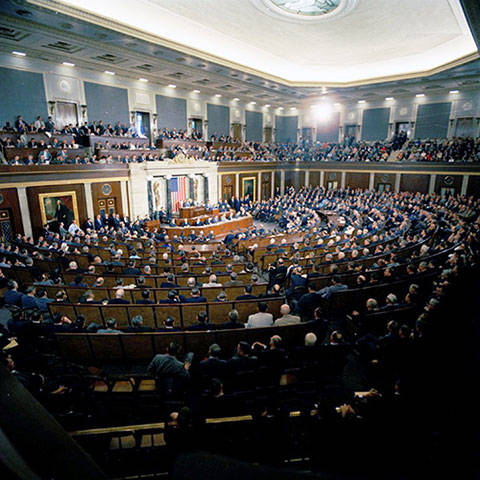

Left: View of the House of Representatives chamber during President
John F. Kennedy’s May 25, 1961, address to a Joint Session of Congress.
Right: President Kennedy addresses the Joint Session of Congress.
In the 16 months following President Kennedy’s speech to Congress, NASA made rapid and significant progress toward achieving the Moon landing goal. To add to its already-existing seven field centers, the agency established three new facilities – the Mississippi Test Facility, now NASA’s Stennis Space Center in Bay St. Louis, Mississippi, on Oct. 25, 1961; the Manned Spacecraft Center (MSC), now NASA’s Johnson Space Center in Houston, on Nov. 1, 1961; and the Launch Operations Center, now NASA’s Kennedy Space Center (JSC) in Florida, on July 1, 1962. Mercury astronauts completed one additional suborbital flight and two orbital missions with preparations underway for the third in October 1962. The agency established Project Gemini on Dec. 7, 1961, and contracted with the McDonnell Aircraft Corp. in St. Louis to build the two-person spacecraft designed to test many of the key techniques required for the Moon landing. The Apollo spacecraft, planned to take astronauts to the Moon, advanced in its design, as did the giant Saturn V Moon rocket, while the smaller Saturn I – then the most powerful rocket in the world – flew two successful suborbital test missions. In July 1962, the agency chose Lunar Orbit Rendezvous as the method most likely to succeed in getting astronauts to the Moon within the President’s timeframe. While unpiloted probes to explore the Moon ahead of astronaut missions had so far been met with limited success, the Mariner 2 spacecraft left Earth in August 1962 on its pioneering mission to explore the planet Venus.
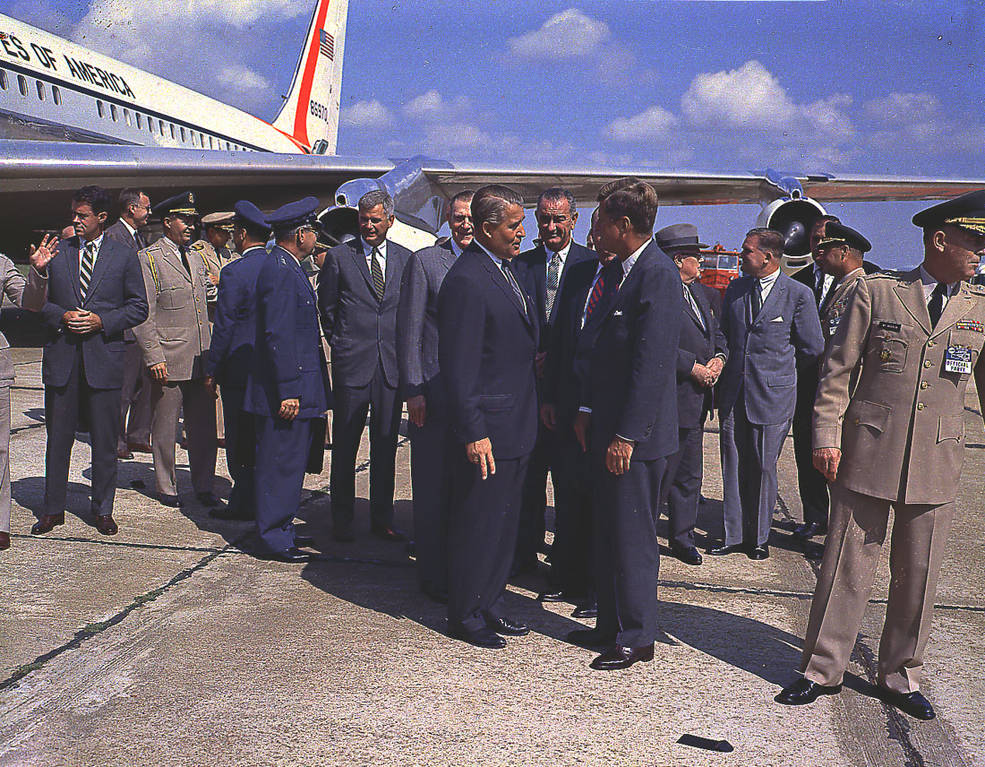
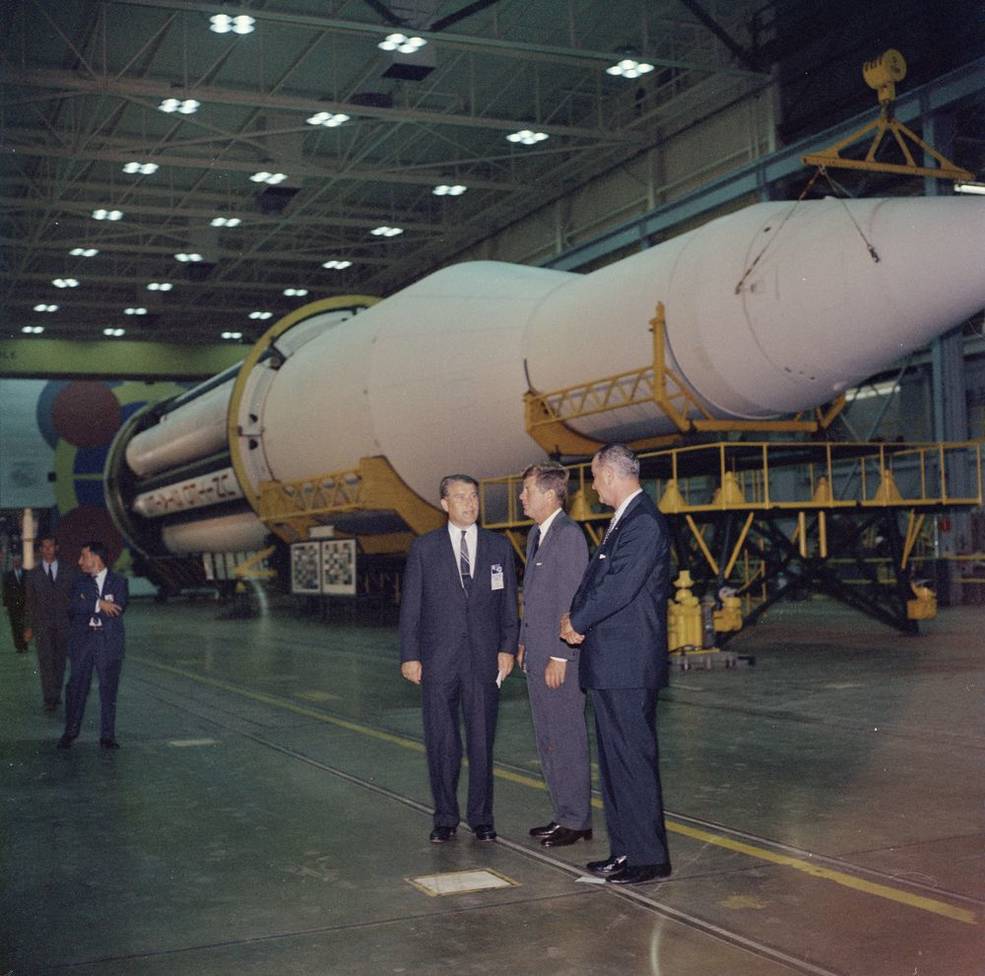
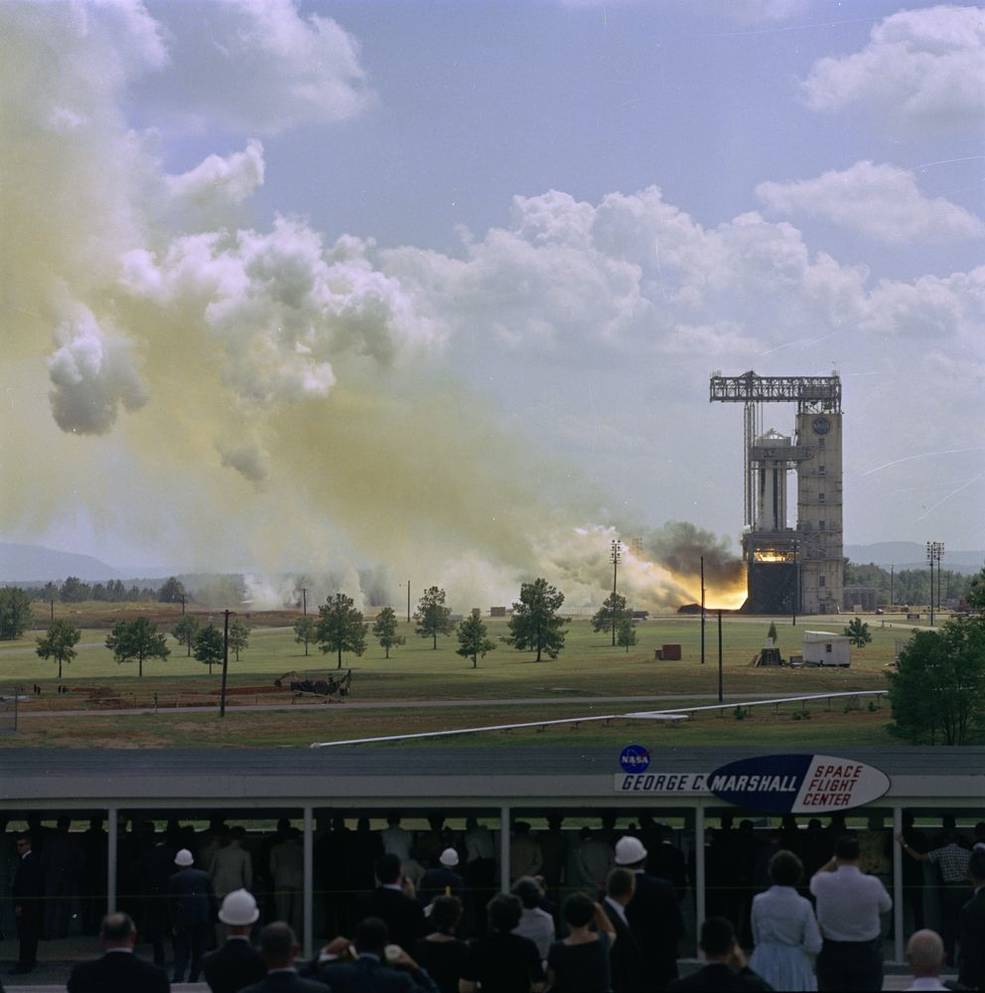
Left: President John F. Kennedy arrives at NASA’s Marshall Space Flight Center in Huntsville,
Alabama, greeted by Director Wernher von Braun. Middle: At Marshall, Center Director von Braun,
left, describes the Saturn I rocket to President Kennedy and Vice President Lyndon B. Johnson.
Right: President Kennedy observes a test firing of a Saturn I first stage.
Image credits: Courtesy JFK Library.
Vice President Lyndon B. Johnson, who served as the chairman of the National Aeronautics and Space Council, NASA Administrator James E. Webb, and other officials accompanied the President on his fact-finding tour. They arrived at their first stop, NASA’s Marshall Space Flight Center (MSFC) in Huntsville, Alabama, on the morning of Sept. 11. Director Wernher von Braun, who designed the Jupiter rocket that launched the first U.S. satellite Explorer 1 in January 1958 as well as the Saturn family of rockets, greeted them at the Redstone Arsenal Airfield. After a brief visit to the U.S. Army Missile Command at the Redstone Arsenal, co-located with MSFC, the President observed a 30-second static test firing of the first stage of the SA-4 Saturn I rocket, at the time the most powerful booster in the world. Apparently, the test firing made a great impression on the President. Director von Braun then took the President to see a fully assembled Saturn I rocket, explaining how the Saturn V rocket to take astronauts to the Moon would be significantly larger and more powerful.
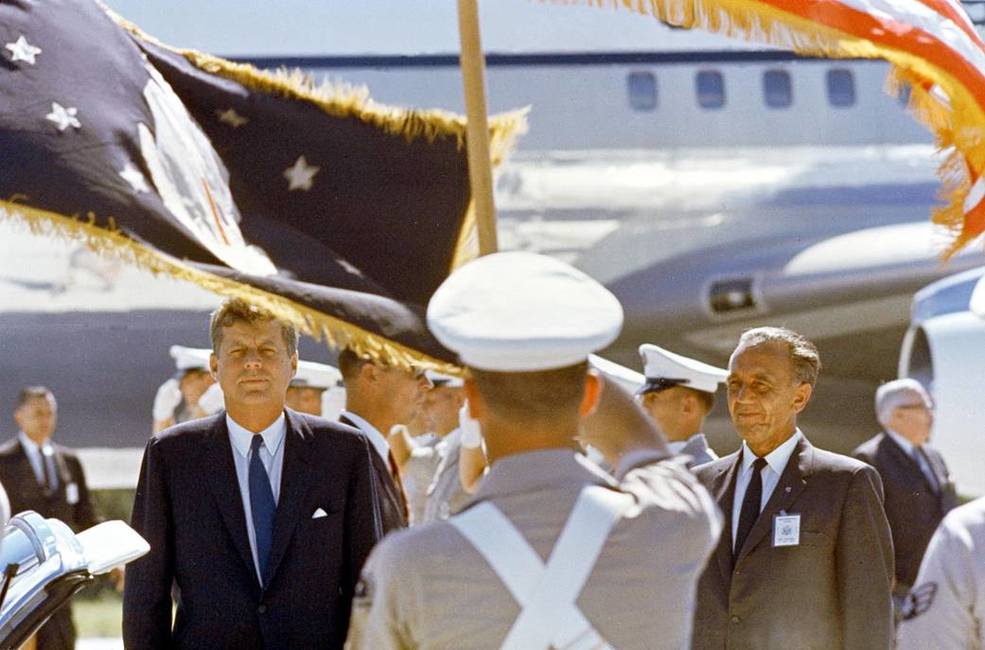


Left: President John F. Kennedy arrives at Cape Canaveral, Florida, greeted by Launch Operations
Center Director Kurt H. Debus. Middle: Astronaut Walter M. Schirra tours President Kennedy at
Launch Complex 14, where his Sigma 7 spacecraft sits atop its Atlas booster for his upcoming
Mercury 8 mission. Right: President Kennedy tours Saturn I Launch Complex 34, with the
blockhouse in the foreground and the gantry in the background.
Image credits: Courtesy JFK Library.

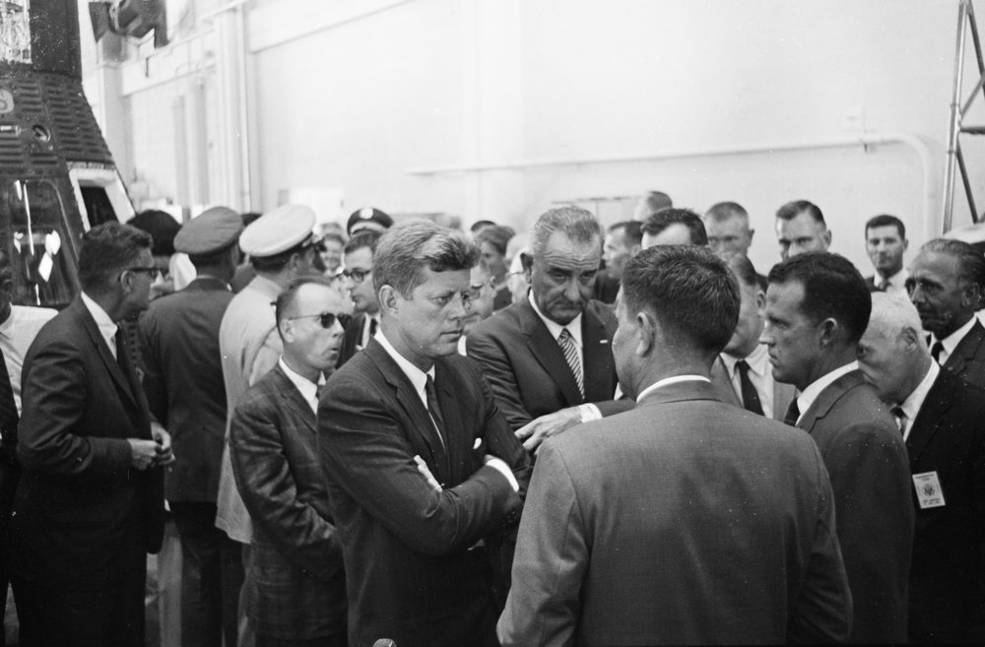

Left: At Cape Canaveral, President John F. Kennedy, fourth from left, listens to a briefing in
the blockhouse at Launch Complex 34. Middle: In Hangar S, astronaut L. Gordon Cooper
describes a Mercury capsule to President Kennedy. Image credits: Courtesy JFK Library.
Right: President Kennedy addresses workers outside Hangar S at Cape Canaveral.
That afternoon, the presidential plane flew the President and his entourage from Alabama to Florida for their second stop, the launch facilities at Cape Canaveral. Kurt H. Debus, director of the recently-established LOC, greeted them at the Skid Strip. This marked President Kennedy’s second time at Cape Canaveral, following his February 1962 visit to greet astronaut John H. Glenn after his historic spaceflight. At the first stop, astronaut Walter M. Schirra welcomed the President at Launch Complex 14, where his Sigma 7 Mercury spacecraft stood atop an Atlas rocket, ready for his six-orbit spaceflight the following month. Continuing north on Cape Canaveral’s missile row, at Launch Complex 16 President Kennedy saw a Titan-II rocket, the type of rocket to carry the Gemini spacecraft into orbit. Further north, the President made stops at two Saturn launch complexes. In Launch Complex 34’s blockhouse, he received a briefing from Saturn Project Officer Rocco A. Petrone on the facilities to support Saturn rockets, and then he toured the nearby Launch Complex 37, still under construction. The visit ended in Hangar S, where astronaut L. Gordon Cooper provided the President with a briefing on the Mercury capsule and the President toured an altitude chamber. Outside Hangar S, President Kennedy gave a few remarks to the assembled employees, stressing that although the Soviet Union may have had the initial advantage in the space race, through the efforts of people at Cape Canaveral, the United States would ultimately take the lead. The President returned to his aircraft at the Skid Strip and departed Cape Canaveral, bound for Houston.
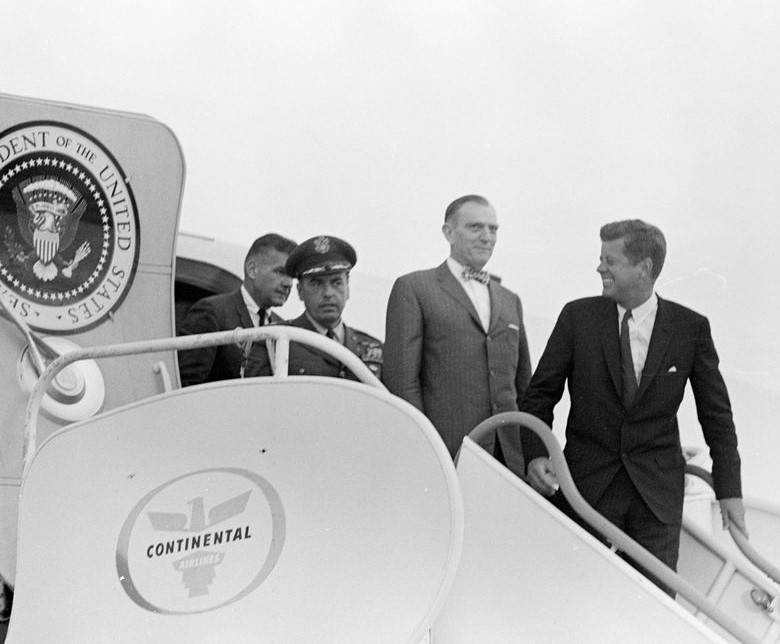


Left: President John F. Kennedy arrives at Houston International Airport, now William P. Hobby
Airport. Image credit: Courtesy JFK Library. Middle: President Kennedy’s
motorcade leaves the Rice Hotel in downtown Houston bound for Rice University.
Right: The motorcade makes its way through downtown Houston, with the
Rice Hotel visible at far right.
Upon the President’s arrival at Houston International Airport, now William P. Hobby Airport, Houston Mayor Lewis W. Cutrer greeted him on the runway. Mayor Cutrer noted that the event marked the first time that a President and a Vice President visited Houston at the same time. Speaking to an estimated 25,000 people, the President expressed his “warm appreciation for this welcome,” adding, “it is most appropriate that the Manned Spacecraft Center should be located here in Houston, identified as the most progressive city in this area.” The presidential motorcade rolled from the airport to the Rice Hotel in downtown Houston where the President spent the night. An estimated 172,000 people lined the motorcade route to the hotel, where an additional 3,000 more congregated to welcome the President.

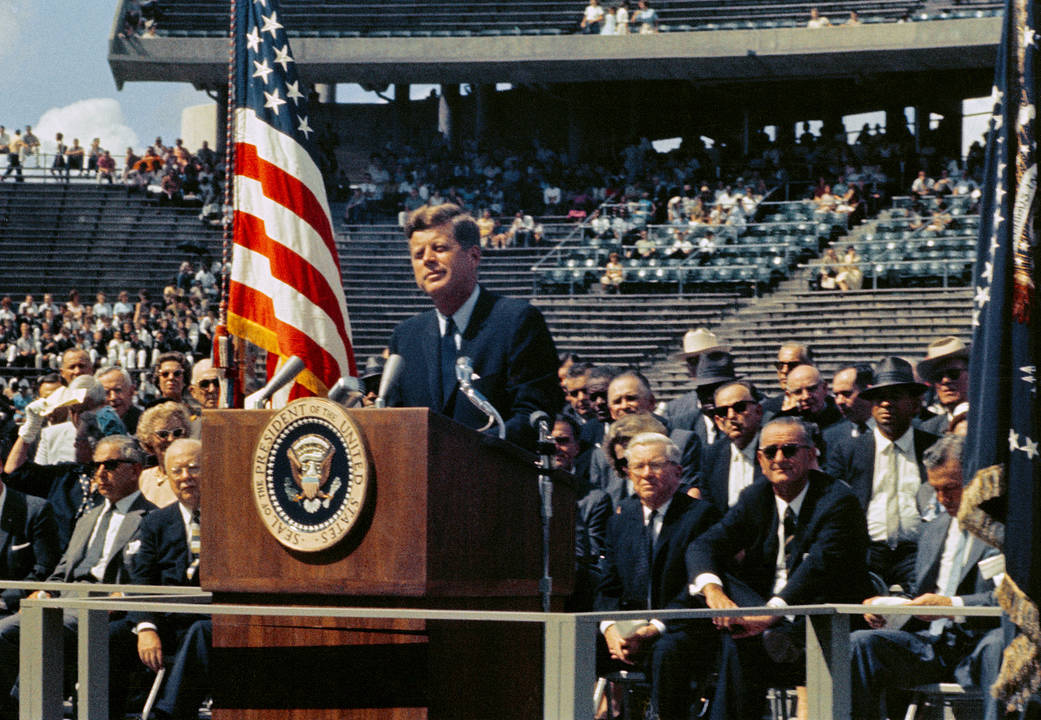

Left: President John F. Kennedy arrives in Rice University’s football stadium.
Image credit: Courtesy Woodson Research Center, Fondren Library, Rice University.
Middle: President Kennedy addresses a crowd in Rice University’s stadium reaffirming his support
for America’s space program, including landing a man on the Moon. Right: A view of the crowd in
Rice stadium during the President’s address. Image credit: Courtesy JFK Library.
The morning of Sept. 12, the motorcade brought the President to Rice University with an estimated 300,000 people lining the route along Main Street. Kenneth S. Pitzer, president of Rice University, escorted President Kennedy into the football stadium and introduced him to the assembled crowd of 40,000 people. Classes had not yet resumed for the fall term, but first-year students had arrived for orientation and attended the ceremony, along with school children bused in from around Houston for the event. In the speech officially titled the “Address at Rice University on the Nation’s Space Effort”, President Kennedy repeated comments he made in Huntsville and Cape Canaveral that although the Soviet Union had taken the initial lead in the space race, the United States space program had made bold strides to catch up and that he intended America to take the lead in the coming years. Linking this forward progress with where he spoke, Kennedy said, “… this city of Houston, this State of Texas, this country of the United States was not built by those who waited and rested and wished to look behind them.” He continued, “ We set sail on this new ocean because there is new knowledge to be gained … and used for the progress of all people.” The President addressed those who doubted the Moon landing goal, saying, “But why, some say, the moon? Why choose this as our goal? And they may well ask why climb the highest mountain. Why, 35 years ago, fly the Atlantic?” In a line not in the original speech, he added his own penciled-in question, “Why does Rice play Texas?” that drew so much cheering it nearly drowned out his next point, perhaps the most often-remembered of the speech. Prepared to answer his own question, he eloquently reaffirmed the commitment he made before Congress in May 1961,
“We choose to go to Moon in this decade and do the other things, not because they are easy but because they are hard; because that goal will serve to organize and measure the best of our energies and skills, because that challenge is one that we are willing to accept, one we are unwilling to postpone, and one we intend to win, and the others, too.”
To close his speech, the President referred to British mountaineer George Mallory, who when asked why he wanted to climb Mt. Everest, replied, “Because it is there.” President Kennedy concluded, “Well, space is there, and we’re going to climb it, and the moon and the planets are there, and new hopes for knowledge and peace are there. And, therefore, as we set sail we ask God’s blessing on the most hazardous and dangerous and greatest adventure on which man has ever embarked.” The podium that President Kennedy used is on display at Space Center Houston.
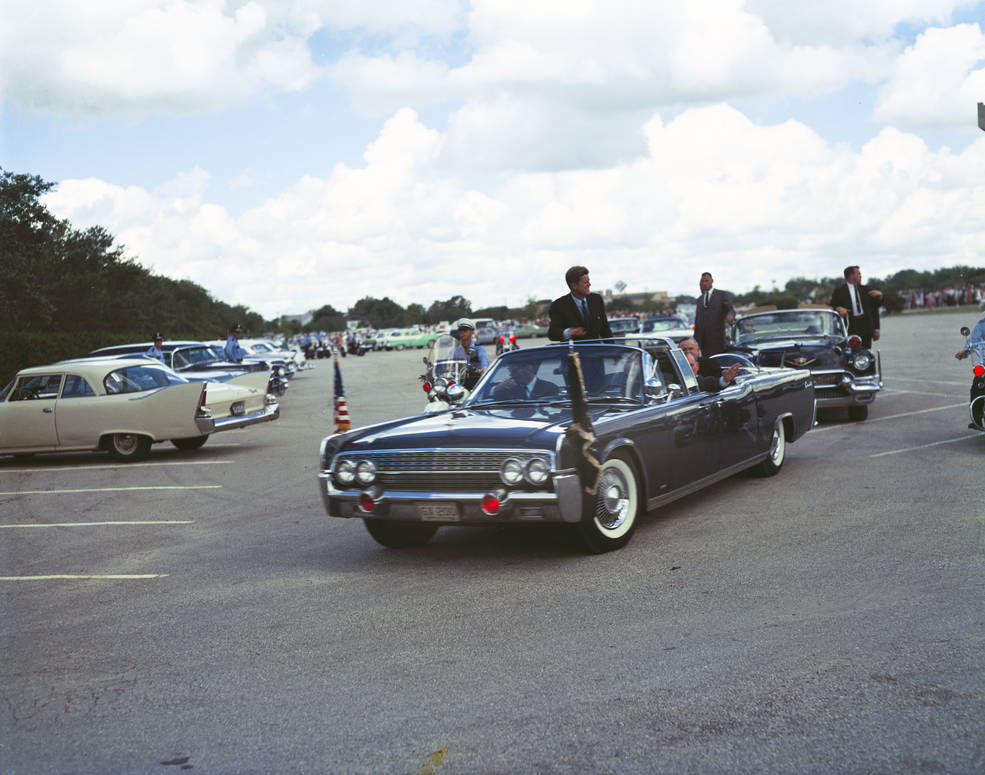
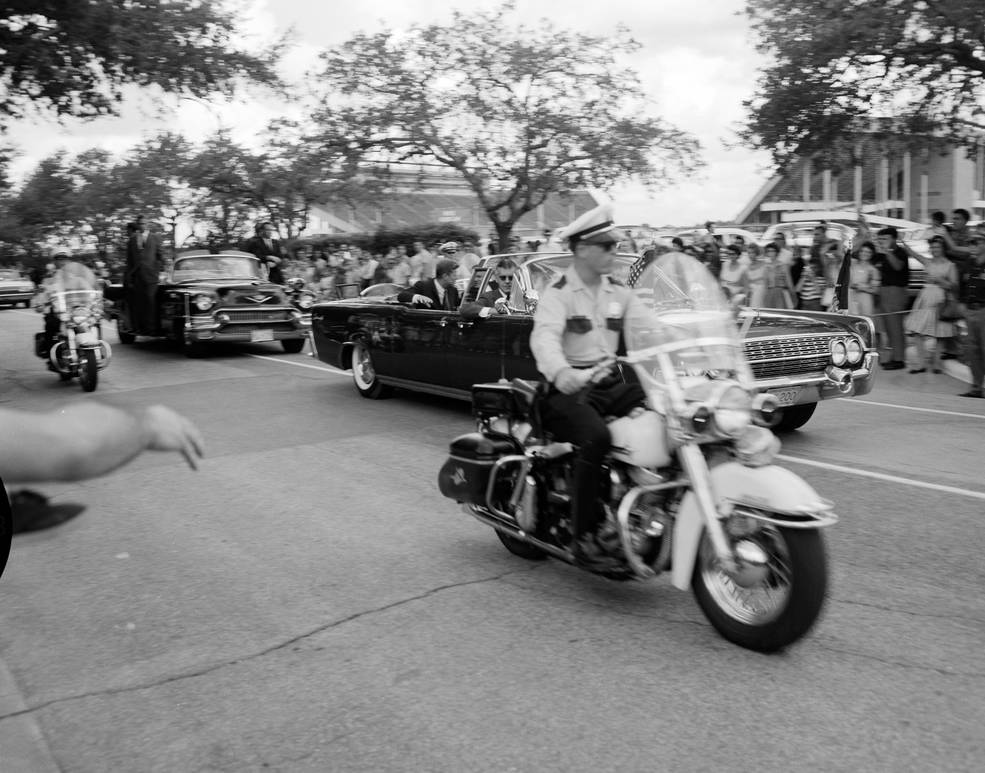
Left: President John F. Kennedy and his motorcade depart the Rice University stadium.
Right: The motorcade leaves the Rice University area, the stadium visible in the
background. Image credits: Courtesy JFK Library.
Following the speech, the presidential motorcade took President Kennedy from Rice University to the Rich Building, also known as Site 13, on Telephone Road, one of the MSC’s leased facilities while construction continued on the main center on Clear Lake. About 40,000 spectators lined the motorcade route to see the President. Seven hundred school children from the nearby J.P. Cornelius Elementary School stood across the street from the Rich Building to welcome President Kennedy. The visit began with Director Robert R. Gilruth and other MSC officials providing the President and Vice President with an hour-long classified briefing on the status of NASA’s human spaceflight program. During the tour in the Rich Building, the President climbed aboard one of the Apollo Command Module mockups with astronaut Donald K. “Deke” Slayton. Astronaut M. Scott Carpenter showed the President his Aurora 7 Mercury capsule, while astronaut John H. Glenn demonstrated astronaut survival gear. The President saw a mockup of a Gemini spacecraft, with astronaut Virgil I. “Gus” Grissom describing its details.
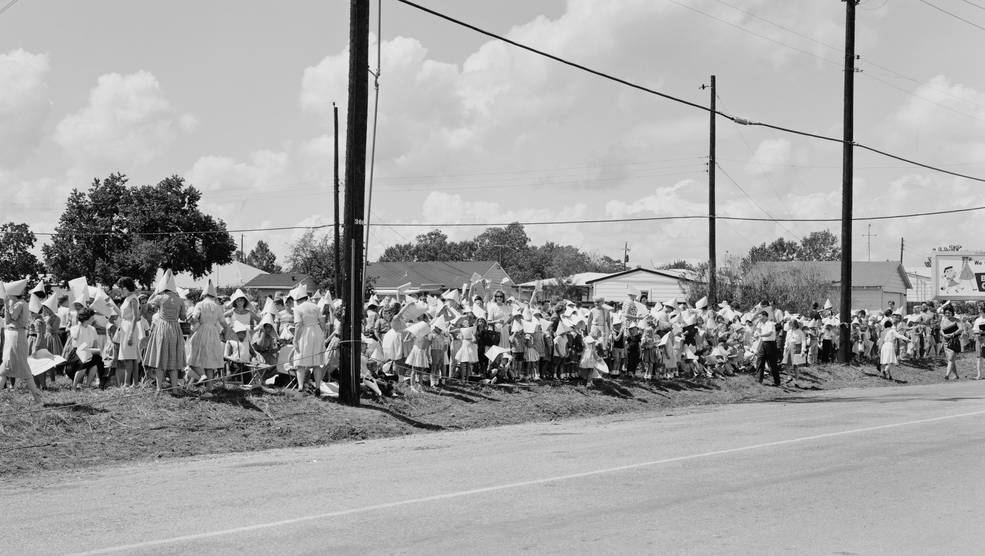

Left: School children line the motorcade route across the street from the Rich
Building,Site 13 of the Manned Spacecraft Center (MSC), now NASA’s Johnson
Space Center.Right: MSC Director Robert R. Gilruth, left, escorts President
John F. Kennedyand Vice President Lyndon B. Johnson to a
classified briefing in the Rich Building.
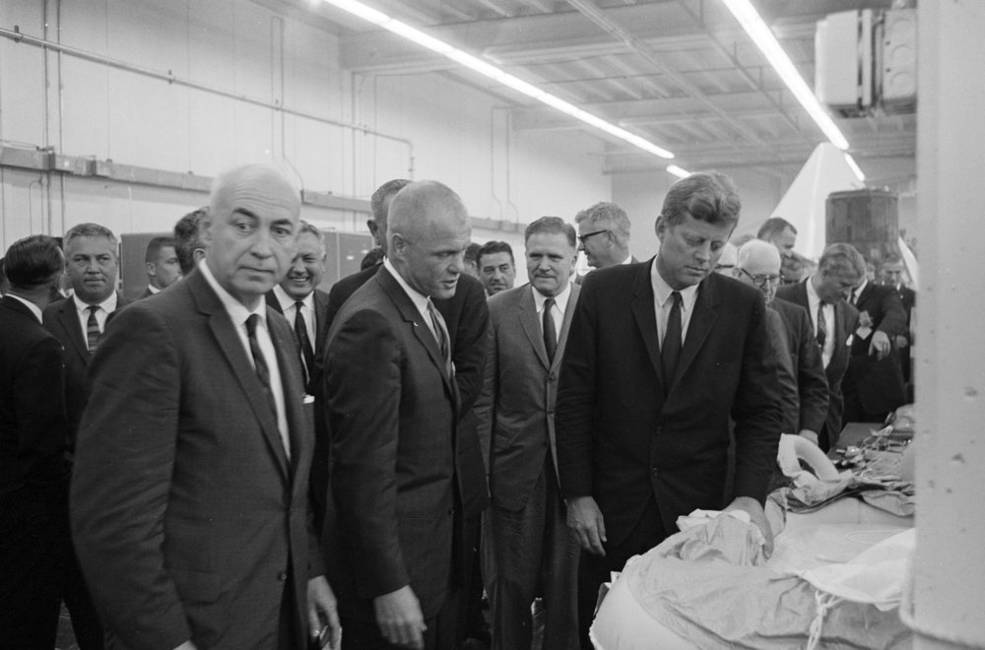

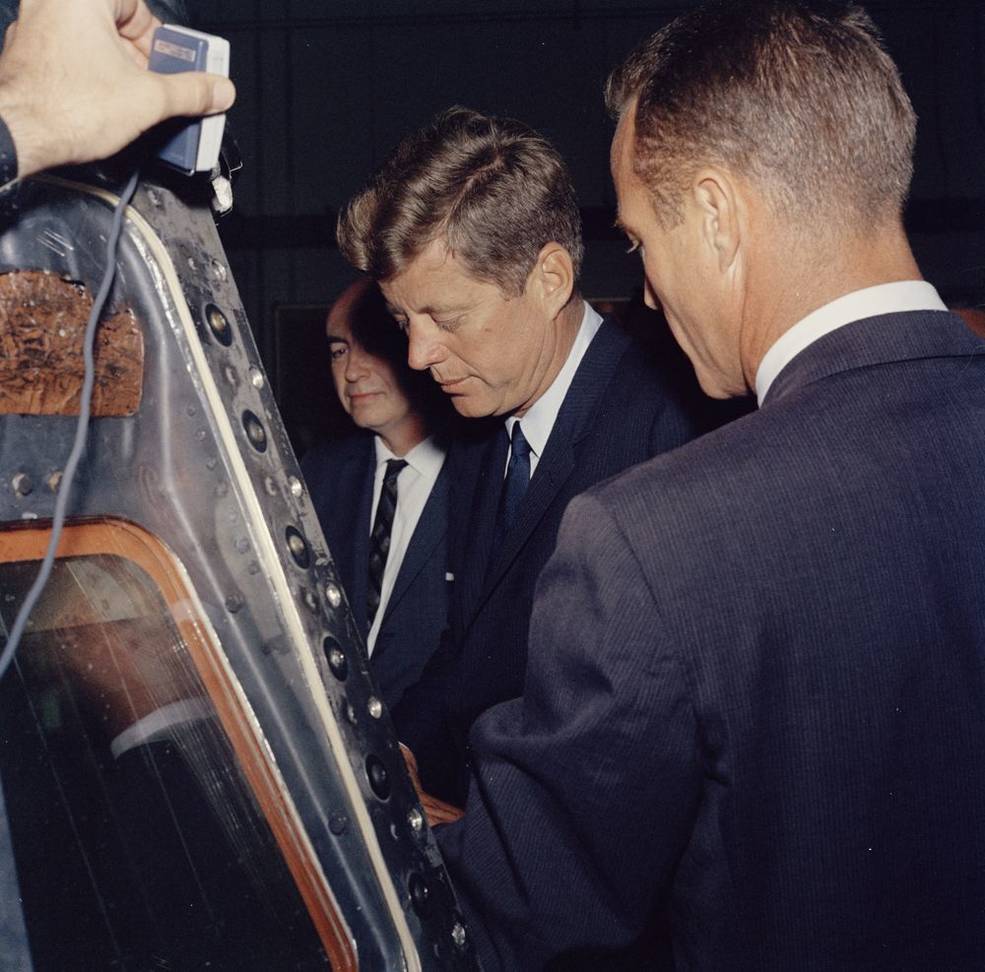
Left: Astronaut John H. Glenn describes survival equipment to President John F. Kennedy.
Middle: Astronaut Virgil I. “Gus” Grissom describes a mockup of a Gemini spacecraft to
President Kennedy. Right: Astronaut M. Scott Carpenter describes his Aurora 7 Mercury
capsule to President Kennedy. Image credits: Courtesy JFK Library.

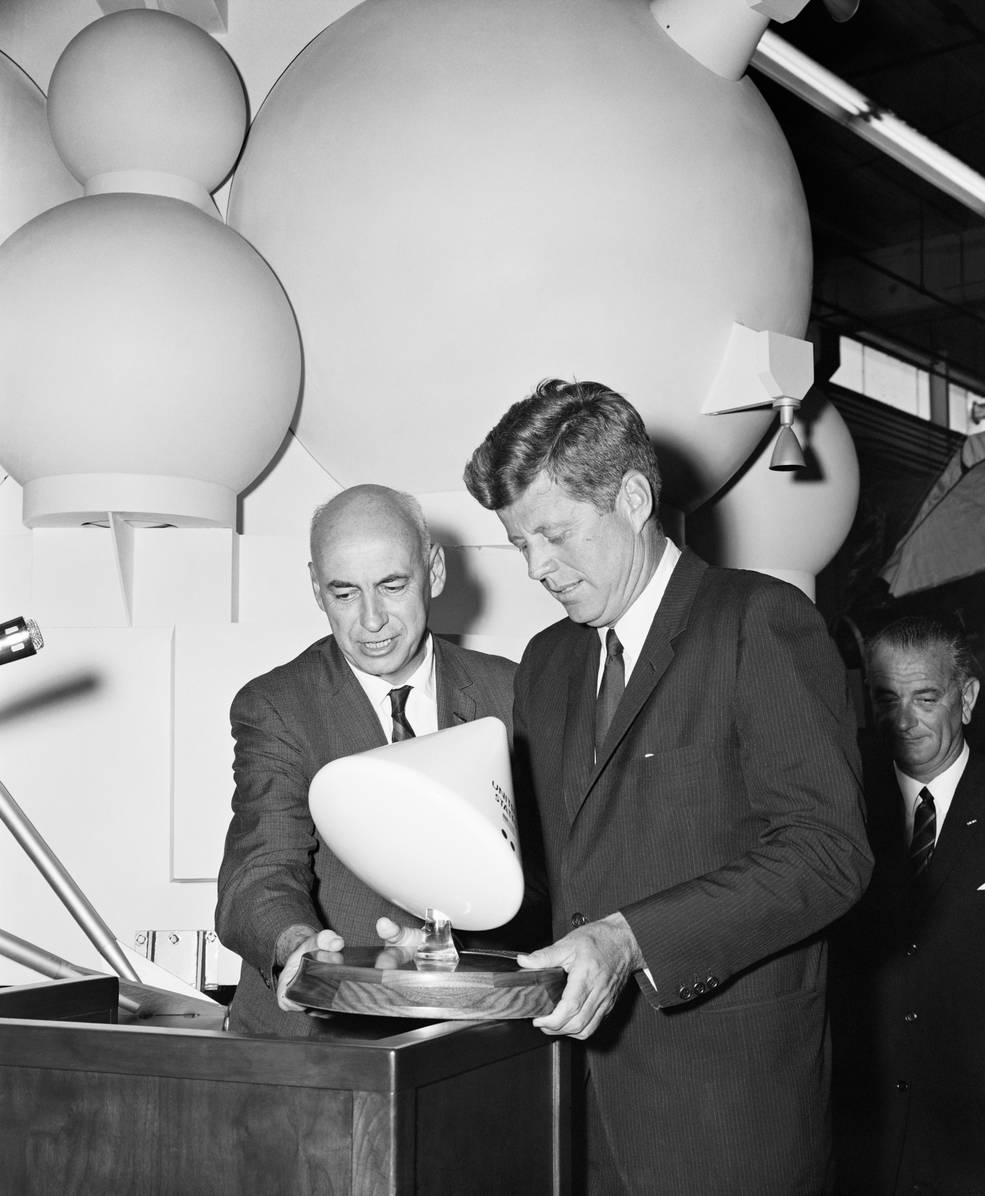

Left: In the Rich Building, astronaut Alan B. Shepard describes the “Lunar Bug,” a model
of a proposed lunar landing vehicle to President John F. Kennedy. Image credit: Courtesy
JFK Library. Middle: Director Robert R. Gilruth presents President Kennedy with a model of
an Apollo Command Module. Right: President Kennedy addresses employees at the Rich Building.
Astronaut Alan B. Shepard described the largest display in the Rich Building as the “Lunar Bug,” a proposed configuration of a lander to take two astronauts to the lunar surface. At the end of the tour, MSC Director Gilruth presented President Kennedy with a desk model of an Apollo Command Module, and the President offered a few remarks to the assembled audience. Of the Moon landing, he said, “We talk about doing this in five or six years. This indicates how far and how fast we have come, and how far and how fast we must go.” Following the visit to the Rich Building, President Kennedy returned to Houston International Airport and took off for his next destination. During the climb-out, the presidential plane flew over the site of the future MSC on the shore of Clear Lake. Groundbreaking had taken place the previous April and construction had progressed to the site preparation stage.



Left: President John F. Kennedy arrives in St. Louis. Middle: President Kennedy addresses
workers outside the McDonnell Aircraft plant in St. Louis. Right: President Kennedy receives
a demonstration of a Gemini spacecraft. Image credits: Courtesy JFK Library.
For the final stop on his tour, President Kennedy visited the McDonnell Aircraft Corporation’s plant in St. Louis. Chief Executive Officer, James S. McDonnell, greeted the President upon his arrival at Lambert-St. Louis Municipal Airport, now St. Louis Lambert International Airport, the location of the plant. The President gave a short speech to the assembled workers, praising them not only for their work on the Mercury and Gemini spacecraft but also for building the F-4 Phantom fighter jet, with several of the aircraft displayed on the tarmac behind him. Inside the plant, President Kennedy viewed a mockup of a Gemini spacecraft, with McDonnell and his team providing detailed descriptions. From St. Louis, the President and his entourage returned to Washington, D.C., having completed a busy two-day inspection tour of space facilities and reaffirming his commitment to landing a man on the Moon and returning him safely to the Earth by the end of the decade. Although President Kennedy did not live to see the historic event, the nation met his goal in July 1969 when Apollo 11 landed the first humans on the Moon and returned them safely to Earth.



Left: In April 2019, NASA Administrator Jim Bridenstine addresses a crowd outside the
Rice University football stadium. Image credit: Courtesy Rice University/Jeff Fitlow.
Middle: The plaque outside the football stadium commemorating President John F. Kennedy’s
1962 speech at Rice University. Right: The second-generation sycamore Moon tree outside
the Rice University football stadium in August 2022.
In April 2019, to celebrate the 50th anniversary of the first Moon landing, the fulfillment of President Kennedy’s challenge to the nation, NASA Administrator Jim Bridenstine visited Rice University, his alma mater. He gave a speech outside Rice Stadium, unveiled a plaque commemorating the site of President Kennedy’s 1962 historic speech, and planted a second-generation Moon tree.
Today, the nation finds itself boldly committed to return astronauts to the Moon, once again setting sail on the new ocean to gain new knowledge for all humanity, this time with the participation of international partners and commercial entities to achieve these goals. In the near future, the Artemis program will land the first woman and the first person of color on the Moon, leading to a permanent presence on the lunar surface as a stepping stone to exploration missions to Mars.

The Space Launch System rocket topped with an Orion capsule
stands at Launch Pad 39B at NASA’s Kennedy Space Center,
poised to take the first step to return
Americans to the Moon.
On Sept. 10-12, 2022, JSC and Rice University will commemorate the 60th anniversary of President Kennedy’s speech and visit to Houston, culminating with NASA Administrator Bill Nelson’s keynote speech.

























